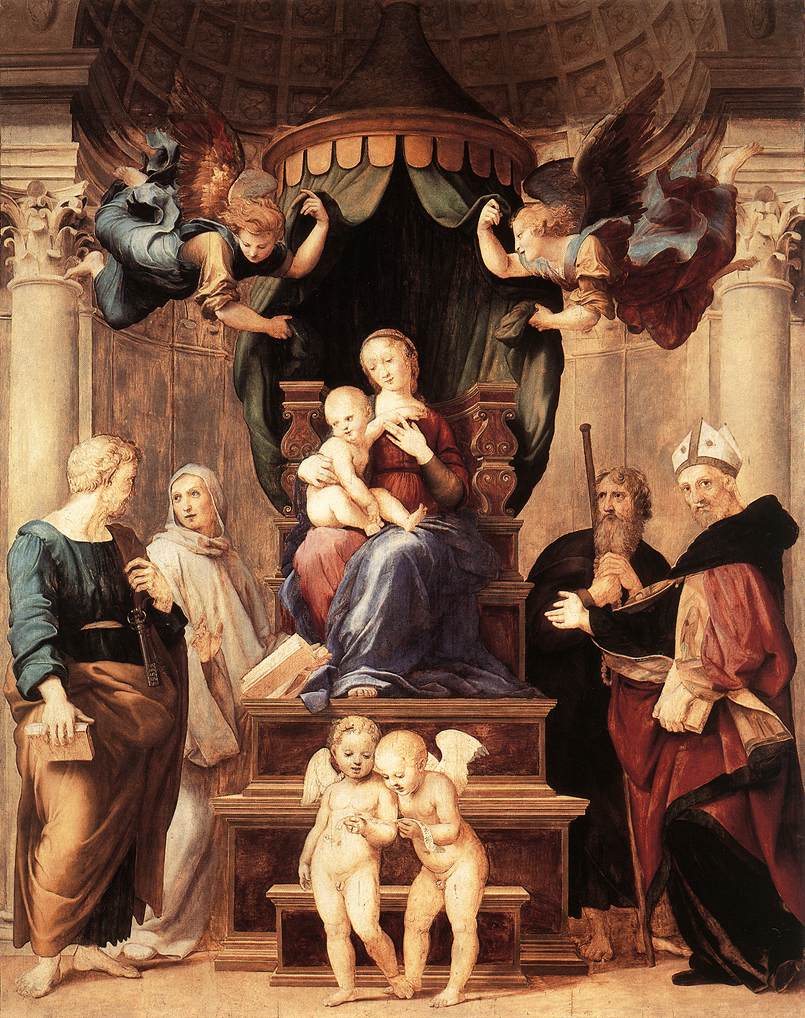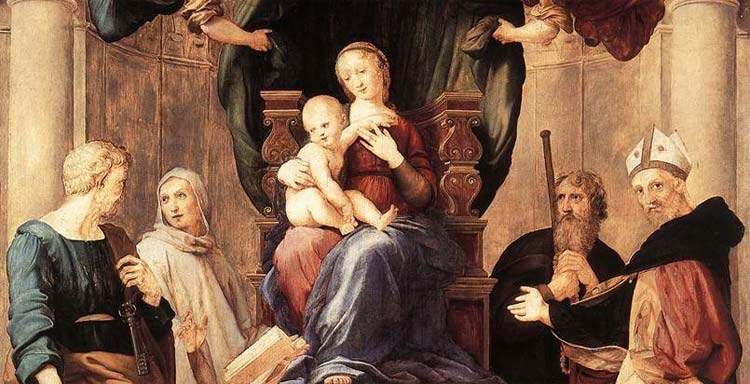Uffizi brings Raphael's Madonna del Baldacchino to Pescia, where it was in ancient times
The Madonna del Baldacchino, Raphael’s unfinished masterpiece, will return to Pescia Cathedral, where it was originally located, from April 29 to July 30, 2023. The Uffizi, the museum that now preserves Raphael Sanzio ’s important altarpiece (in fact, the work is located in Palazzo Pitti, an institution that depends on the Uffizi), has decided to return the Madonna del Baldacchino to its place of origin as part of a special initiative for the Uffizi Diffusi project. Supporting and fully financing the ambitious operation is the Fondazione Cassa di Risparmio di Pistoia e Pescia.The Madonna del Baldacchino is currently at the Opificio delle Pietre Dure in Florence, where, in preparation for the “move,” it was subjected to careful diagnostic investigations to assess its state of health. The specialists’ response has established that the work is fine, can be moved to Pescia and displayed in the cathedral without any problems, and only needed very slight consolidation work on the highest portion of the wooden support.
Created by Raphael between 1506 and 1508 on commission from the Dei family, the large altarpiece had been conceived for the church of Santo Spirito in Florence, where, however, it never went. It came into his possession, not many years later, by his friend and executor Baldassarre Turini (1481-1543), a high prelate of the Holy See in the early 16th century as well as a prominent member of the Pescia community. Arriving in the town of Valdinievole, the painting was placed in the cathedral, on the altar of the Turini’s chapel-mausoleum that Baldassarre himself had had erected between the 1430s and 1440s also to worthily accommodate the Urbino altarpiece. The Madonna del Baldacchino remained there for a century and a half, until 1697: in that year it was purchased by Grand Prince Ferdinando de’ Medici, who brought it back to Florence to the palace of Palazzo Pitti, its current home, where it is displayed among the masterpieces of the Galleria Palatina. The copy painted by Pier Dandini was placed in Pescia Cathedral: this painting, too, has undergone inspection and restoration in recent months, in preparation for the exhibition that will soon compare it with Raphael’s original.

“Re-examining the great altarpiece almost forty years after the previous, historic intervention,” comments Opificio delle Pietre Dure Superintendent Emanuela Daffra, “has allowed us to verify the tightness of the latter, to take stock of the painting’s current condition, and to review our knowledge of it in light of extraordinarily advanced investigation technologies. It is certainly a less striking intervention than a ’revelation restoration,’ but valuable in terms of long-term knowledge, monitoring and critical review of solutions adopted in the past. It is a rigorous and forthright research approach that characterizes the work of the restoration laboratories of the Opificio delle Pietre Dure: the recently renewed agreement between the two institutes - Opd and Gallerie degli Uffizi - offers the ideal context for cultivating it.”
"The main criterion of Operation Uffizi Diffusi," says Uffizi Director Eike Schmidt, “is the reconstruction of the historical fabric and artistic events in the various centers where the works are exhibited. Certainly bringing Raphael’s Madonna del Baldacchino to Pescia is an operation of exceptional weight, which not only seeks to recall the original furnishings of the cathedral but also highlights the figure of an important Pescia resident such as Baldassarre Turini.”
“In addition to having an undisputed artistic value,” stresses Lorenzo Zogheri, president of the Fondazione Cassa di Risparmio di Pistoia e Pescia, “the project is part of the Valdinievole enhancement program that we are carrying out together with local authorities and the Diocese with the intention of bringing there a quality tourism that knows how to delve into the themes of the area and can share its values and experiences.”
"Raphael’s Madonna of the Canopy, one of the most famous and admired works of the Florentine Galleria Palatina in the Pitti Palace," says Region of Tuscany President Eugenio Giani, “returns after centuries to its original location, inside the Cathedral of Pescia where it can be admired as part of the special project connected to the Uffizi diffused. This is exceptional news not only for the visitors who will be able to admire it in the town of Valdinievole, outside the traditional circuit of art tourism, but also and above all because it is a concrete demonstration of the effectiveness of a project capable of expanding over the entire regional territory and enhancing the relationship between art, history and territory. It is a project that the Region supports with great conviction. It is a support that we hope soon to concretize also with a regional law that helps to find new ways to enhance the territory and to bring back to each area the works most closely related to it.”
For the bishop of Pescia Monsignor Roberto Filippini, “The possibility of contemplating Raphael’s masterpiece in its original location, next to Dandini’s refined 18th-century copy, will be an opportunity for many to retrace an arc of art history that is among the mostart history among the most evocative and fruitful and to be able to situate it in a religious architectural adventure of extraordinary interest such as the Cathedral of Pescia, in its becoming, from the Romanesque Pieve to the adaptations of the different epochs, up to today. For the Church of Pescia, moreover, the contemplation of the Urbino Altarpiece will allow it to return again to its origins, and almost to prolong that Jubilee of its 500th anniversary, abruptly interrupted by the pandemic. Finally, the display of the Madonna of the Canopy will be able to offer a further reason to reconsider the importance of the path of beauty in the experience of the transcendent.”
Finally, according to Pescia Mayor Oreste Giurlani, “The return of Raphael’s panel to Pescia is, in addition to being a great event under the artistic-cultural profile, a formidable promotional opportunity for our city, which, with this exhibition, turns on itself the attention of a potentially vast public; the Municipality of Pescia, which, I must say, is moving according to a Strategic Plan for Culture approved by the City Council, is ready, also with the recently reopened Civic Museum and the Libero Andreotti Plaster Casts Gallery, to welcome those who will want to come and enjoy Pescia’s integrated cultural offer.”
 |
| Uffizi brings Raphael's Madonna del Baldacchino to Pescia, where it was in ancient times |
Warning: the translation into English of the original Italian article was created using automatic tools. We undertake to review all articles, but we do not guarantee the total absence of inaccuracies in the translation due to the program. You can find the original by clicking on the ITA button. If you find any mistake,please contact us.





























